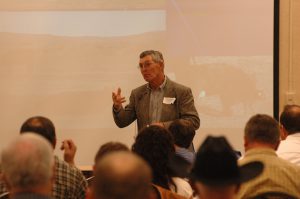It takes time to build a good relationship — time, trust and technique. Yesterday, in Part I of “Making calving season a breeze,” we talked about how important it is to develop those good relationships early in an animal’s life. It starts with putting in some extra time, but Dr. Tom Noffsinger had a few more ideas focused on technique to will build that trust between animals and caregivers.

Here are a few other great animal handling tips Dr. Tom shared that day at the Feeding Quality Forum:
For calving:
- “Cows should never go through a gate without her calf by her side.” If they must be transported, move them as pairs. In grazing situations, don’t force mammas and babies to separate to find food.
- “We as caregivers can enhance the number of times a baby nurses.” If a cow doesn’t trust her caregiver, she’ll hide her baby and only go back to nurse 2-3 times a day. That decreases the amount of transferred immunity and other vital maternal bonding the calf gets.
For processing:
- “Never process calves until they are willing to leave their favorite corner and go single-file into an ally.” Taking the time to move animals through every corner of each place they will be staying – each pen, pasture, processing facility or barn – is essential to building animal-caregiver relationships. If they trust the facility, they’ll trust what you want them to do in it, too.
- “Those electric prongs are just like a can of beer – if you have them in your hand,you will probably use it.” ‘Hot-shots’ and other tools that startle animals into movement should be avoided. Having one in your hand will inevitably lead to over-using it and causing animals to balk and startle the rest of the herd.
General handling:
- “If you are working behind an animal,you need to know that is an incredibly ineffective place to be.” Cattle want to be able to see you and see what is pressuring them. They react best to what they can see. It’s important to understand animals’ flight zones to do this effectively.
- “Speak the language of the cattle – that doesn’t involve using our voices.” Instead, he says, good stockmanship relies on non-verbal communication – it’s all about the position, distance, speed and angle of the stockman in respect to the animal. Again, refer to animals’ flight zones to learn to control those techniques.
I found a short video produced by Cattle Network with an interview they did with Dr. Tom. If you’re interested in learning more about why he believes these handling techniques are so important, it’s a good overview.
Enjoy!
-Laura
